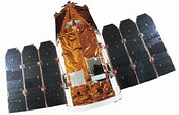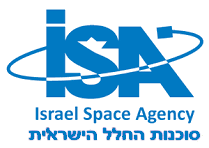
Shavit 2 is a small lift launch vehicle produced by Israel from 1982 onwards, to launch satellites into low Earth orbit. It was first launched on 19 September 1988, making Israel the eighth nation to have an orbital launch capability after the USSR, United States, France, Japan, People's Republic of China, United Kingdom, and India.

Israel Aerospace Industries or IAI (תע"א) is Israel's major aerospace and aviation manufacturer, producing aerial and astronautic systems for both military and civilian usage. It has 15,000 employees as of 2018. IAI is completely state-owned by the government of Israel.

Ofeq, also spelled Offek or Ofek is the designation of a series of Israeli reconnaissance satellites first launched in 1988. Most Ofek satellites have been carried on top of Shavit 2 rockets from Palmachim Airbase in Israel, on the Mediterranean coast. The low Earth orbit satellites complete one Earth orbit every 90 minutes. The satellite launches made Israel the eighth nation to gain an indigenous launch capability. Both the satellites and the launchers were designed and manufactured by Israel Aerospace Industries (IAI) with Elbit Systems' El-Op division supplying the optical payload.

Earth Resources Observation Satellite (EROS) is a series of Israeli commercial Earth observation satellites, designed and manufactured by Israel Aircraft Industries (IAI), with optical payload supplied by El-Op. The satellites are owned and operated by ImageSat International (ISI), another Israeli company, with some 35 full-time employees. EROS A was launched on December 5, 2000 and EROS B on April 25, 2006.

The Israel Space Agency is a governmental body, a part of Israel's Ministry of Science and Technology, that coordinates all Israeli space research programs with scientific and commercial goals.

Amos is a series of Israeli communications satellites operated by Israel-based Spacecom. All Amos satellites were developed by Israel Aerospace Industries using the AMOS bus platform, except for Amos-5 which was developed by JSC Reshetnev using the Ekspress bus platform, and Amos 17 which was developed by Boeing on its 702 platform.
Spacecom, or Space Communication, is an Israeli communications satellite operator in the Middle East, European Union and North America headquartered in the city of Ramat Gan, Israel. Spacecom operates two satellites at orbital position 4° West – Amos-3 and Amos-7, one satellite at orbital position 65° East – Amos-4, and one satellite at orbital position 17° East – Amos-3.
Intelsat 24, previously Amos-1, is a commercial communication satellite which is operated by Intelsat. It was previously operated by Spacecom as Amos-1, and formed part of the AMOS series of satellites. It was the first Israeli civilian communications satellite, and was initially positioned at 4° West longitude in geostationary orbit. It has since been moved to 47.3 degrees East.
EL/M-2070 TecSAR, also known as TechSAR, Polaris and Ofek-8, is an Israeli reconnaissance satellite, equipped with synthetic aperture radar developed by Elta Systems. It was successfully launched at 03:45 GMT on 21 January 2008, by PSLV C-10 Launch Vehicle, from the Satish Dhawan Space Centre in India.

Intelsat 603 or IS-603, previously named Intelsat VI F-3, is a communications satellite operated by Intelsat. Launched in 1990, it was the second of five Intelsat VI satellites to be launched. The Intelsat VI series was constructed by Hughes Aircraft, based on the HS-389 satellite bus.
Ofek-9, also known as Ofeq 9, is part of the Ofeq family of reconnaissance satellites designed and built by Israel Aerospace Industries (IAI) for the Israeli Ministry of Defense.
The Earth Remote Observation System A was part of the EROS family of Israeli commercial Earth observation satellites, designed and manufactured by Israel Aircraft Industries. This was the first satellite in the series. The satellite was owned and operated by ImageSat International.

The Earth Remote Observation System-B (EROS-B) is the second satellite launched in a series of the EROS family of Israeli commercial Earth observation satellites, designed and manufactured by Israel Aircraft Industries. It is owned and operated by ImageSat International. Originally the satellite was to be the first of a constellation of 4 EROS-B satellites, but the 3 following satellites were cancelled, leaving the satellite to be the only EROS-B satellite.

USA-204, or Wideband Global Satcom 2 (WGS-2) is an American military communications satellite which is operated by the United States Air Force as part of the Wideband Global Satcom programme. Launched in 2009, it was the second WGS satellite to reach orbit, and operates in geostationary orbit at a longitude of 60° east.

USA-211, or Wideband Global Satcom 3 (WGS-3) is an American military communications satellite operated by the United States Air Force as part of the Wideband Global Satcom programme. Launched in 2009, it was the third WGS satellite, and final Block I spacecraft, to reach orbit. It is stationed at 12° west in Geostationary orbit.

USA-244, or Wideband Global Satcom 6 (WGS-6) is an American military communications satellite operated by the United States Air Force as part of the Wideband Global Satcom programme. Launched in 2013, it was the sixth WGS satellite to reach orbit. It is stationed at a longitude of 135° west, in geostationary orbit. WGS-6 was procured by the Australian Defence Force for the US Air Force, in exchange for participation in the programme.
Ofek-10, also known as Ofeq 10, is part of the Ofeq family of reconnaissance satellites designed and built by Israel Aerospace Industries (IAI) for the Israeli Ministry of Defense. Ofek-10 is an upgraded variant of Ofek-8, which employs a high-resolution synthetic aperture radar that is capable of observation at night and through clouds.
The AMOS, an acronym for Affordable Modular Optimized Satellite, is a family of light weight satellite buses for geostationary orbit communication designed and manufactured by IAI of Israel.
Ofek-11, also known as Ofeq 11, is part of the Ofeq family of reconnaissance satellites designed and built by Israel Aerospace Industries (IAI) for the Israeli Ministry of Defense.
Ofek-16, also known as Ofeq 16, is an Israeli electro-optical reconnaissance satellite. It is part of the Ofeq family, designed and built by Israel Aerospace Industries (IAI) for the Israeli Ministry of Defence.







